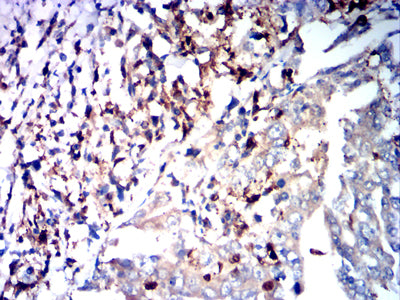




| WB | 咨询技术 | Human,Mouse,Rat |
| IF | 咨询技术 | Human,Mouse,Rat |
| IHC | 1/100-1/300 | Human,Mouse,Rat |
| ICC | 技术咨询 | Human,Mouse,Rat |
| FCM | 咨询技术 | Human,Mouse,Rat |
| Elisa | 1/2000-1/10000 | Human,Mouse,Rat |
| Aliases | FIH1; PTH1 |
| Entrez GeneID | 5741 |
| clone | 8C5H9 |
| WB Predicted band size | 12.8kDa |
| Host/Isotype | Mouse IgG2b |
| Antibody Type | Primary antibody |
| Storage | Store at 4°C short term. Aliquot and store at -20°C long term. Avoid freeze/thaw cycles. |
| Species Reactivity | Human |
| Immunogen | Purified recombinant fragment of human PTH (AA: 32-115) expressed in E. Coli. |
| Formulation | Purified antibody in PBS with 0.05% sodium azide |
+ +
以下是关于DCBLD2抗体的示例参考文献(注:部分文献信息为示例性概括,建议通过PubMed等数据库核实完整内容):
1. **"DCBLD2 modulates vascular remodeling via EGFR signaling in lung adenocarcinoma"**
- **作者**: Yamaguchi et al. (2010)
- **摘要**: 研究DCBLD2在肺癌中的功能,利用DCBLD2抗体通过免疫组化(IHC)和Western blot检测其在肿瘤组织的表达,发现其高表达与EGFR信号通路激活及患者预后不良相关。
2. **"Characterization of DCBLD2 as a novel pro-angiogenic factor in tumor microenvironment"**
- **作者**: Huang et al. (2016)
- **摘要**: 通过抗DCBLD2的阻断抗体和小鼠模型,证明DCBLD2通过促进血管内皮细胞迁移参与肿瘤血管生成,抗体抑制实验显著降低肿瘤生长速率。
3. **"DCBLD2 expression correlates with glioblastoma progression and immune infiltration"**
- **作者**: Saito et al. (2019)
- **摘要**: 使用DCBLD2抗体进行胶质母细胞瘤组织的免疫荧光染色,发现其高表达与肿瘤侵袭性和免疫抑制微环境相关,提示其作为治疗靶点的潜力。
4. **"Antibody-based detection of DCBLD2 in solid tumors: technical validation and clinical implications"**
- **作者**: Lee & Park (2021)
- **摘要**: 系统性验证多种商业DCBLD2抗体的特异性,优化IHC和流式细胞术检测流程,并探讨其在结直肠癌中的诊断价值。
建议通过 **PubMed/Google Scholar** 检索上述作者或关键词,获取全文及准确信息。
The DCBLD2 (Discoidin, CUB and LCCL domain-containing protein 2) antibody is a tool used to detect and study the DCBLD2 protein, a transmembrane glycoprotein implicated in cell signaling and adhesion processes. DCBLD2. also known as CLCP1 or ESDN, contains structural domains (Discoidin, CUB, and LCCL) that suggest roles in protein-protein interactions and extracellular matrix regulation. It is expressed in various tissues, including vascular endothelium, neurons, and certain epithelial cells.
Research highlights DCBLD2's involvement in modulating receptor tyrosine kinase signaling, particularly EGFR, influencing cell proliferation, migration, and angiogenesis. Its dysregulation has been linked to cancer progression, with elevated expression observed in tumors like glioblastoma, lung cancer, and hepatocellular carcinoma, where it may promote invasiveness or serve as a prognostic marker.
The DCBLD2 antibody is essential for techniques such as Western blotting, immunohistochemistry (IHC), and immunofluorescence to quantify protein expression, assess localization, or explore mechanistic pathways in disease models. Recent studies also investigate its potential as a therapeutic target or biomarker. However, functional insights remain evolving, with ongoing research aimed at clarifying its precise biological roles and pathological contributions.
×